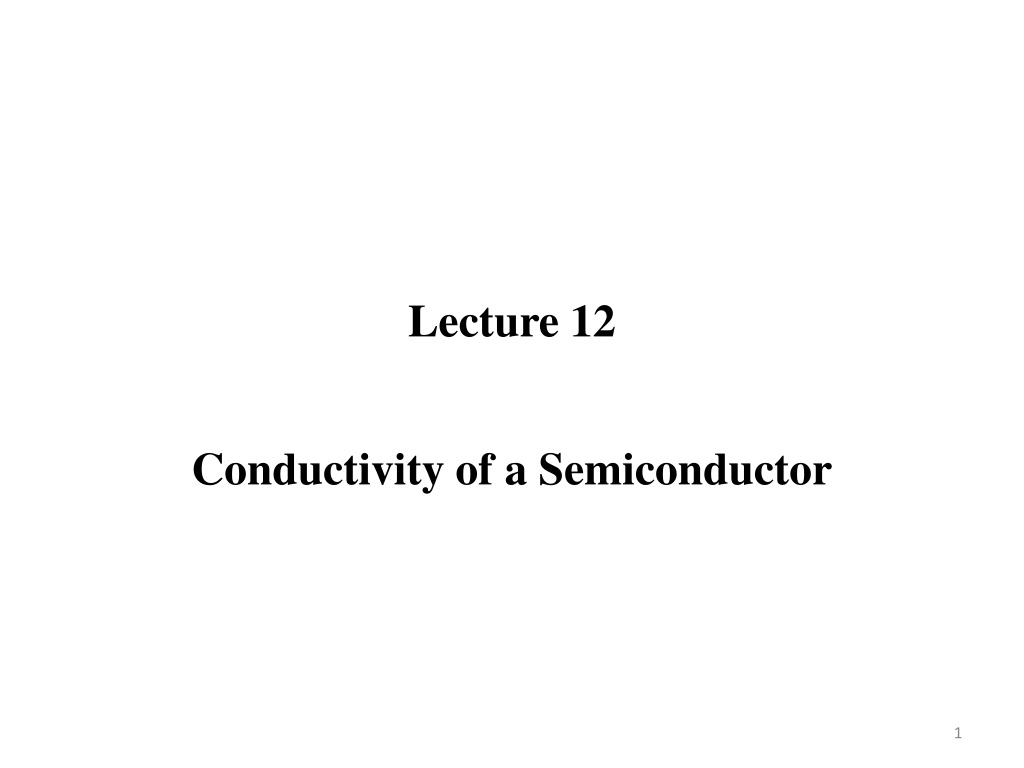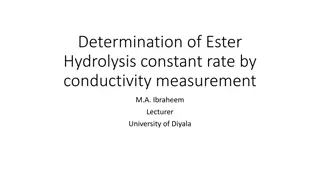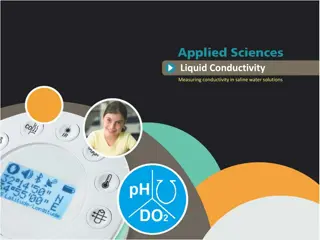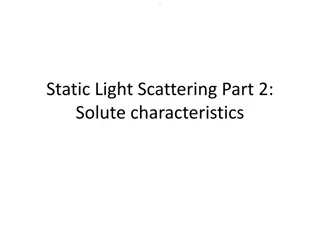Understanding Semiconductor Conductivity and Scattering Mechanisms
In the study of semiconductor conductivity, the concept of degenerate and non-degenerate semiconductors is discussed, showcasing the impact of doping levels. The conductivity equation is explored in terms of electron and hole mobilities and densities. The role of scattering mechanisms, such as lattice and impurity scattering, in determining carrier responsiveness is highlighted. Considerations for temperature dependence and the significance of scattering events on electron behavior are examined.
Download Presentation

Please find below an Image/Link to download the presentation.
The content on the website is provided AS IS for your information and personal use only. It may not be sold, licensed, or shared on other websites without obtaining consent from the author. Download presentation by click this link. If you encounter any issues during the download, it is possible that the publisher has removed the file from their server.
E N D
Presentation Transcript
Lecture 12 Conductivity of a Semiconductor 1
Recap A degenerate semiconductor is a semiconductor with such a high level of doping that the material starts to act more like a metal than as a semiconductor. If we add dopants at much higher concentrations, dopant atoms come much closer to each other and it is no longer valid to assume the donor levels as atom like. If the inter-atomic distance is closer (typically < 10nm) then the atomic levels turn into bands. This leads to significant changes in the crystal structure as well as the physical properties. It is also to be noted that the donors (or acceptors) energy levels are assumed as atom like. Such assumptions are limited up to a certain level of dopant concentration and such extrinsic semiconductors are called non-degenerate semiconductors. 2
Conductivity of a semiconductor = q ( nn + pp ) -------------------------------------------------( 1 ) Where, n and p refer to the mobilities of the electrons and holes, and n and p refer to the density of electrons and holes, respectively. = q n n, For n- type = q p p, For p-type n = e n / mn p = e p / mn n and p are scattering time 3
Conductivity of a semiconductor The scattering time is in terms of a scattering cross section (S) is given by =1 / S Vth Ns------------------------------------------------------(4) Where Vth is the mean speed of the electrons (thermal velocity) and Ns is the number of scatters per unit volume. In a semiconductor, both mobility and carrier concentration are temperature dependent. Thus, it is important to view the conductivity as a function of temperature which is expressed by = q [ n (T) n ( T) + h ( T ) p ( T) ] 4
Types of scattering mechanisms Scattering is what determines how responsive carriers are in a semiconductor. A scattering event is when an electron (or a hole, but let s just mention the electrons for now and keep in mind that everything we say for electrons is valid for holes) bumps into something such that it changes its direction, momentum, and/or energy. An electron can bump into other electrons, holes, ionized impurities, and into phonons lattice vibrations. Obviously, the more of those things there are around, the more frequent the scattering events. 5
Types of scattering mechanisms 1. Lattice scattering : Lattice scattering is the scattering of ions by interaction with atoms in a lattice. This effect can be qualitatively understood as phonons colliding with charge carriers. 2. Impurity Scattering : Impurity scattering becomes important for doped semiconductors. The mobility of the carriers in a semiconductor is also influenced by the presence of charged impurities. Impurity scattering is caused by crystal defects such as ionized impurities. 6
Lattice scattering In an intrinsic semiconductor the carrier scattering is mainly due to thermal vibrations of the lattice (Si atoms). In metals, electron-electron scattering is also important and affects the conductivity, but electron concentration in semiconductors are low so that electron- electron scattering can be ignored. For lattice scattering, if a is the amplitude of the lattice vibrations for a simple two dimensional scattering, S is just a2. As temperature increases, a increases and hence S increases. =1 / S VthNs------------------------------------------------------(4) The second term in equation 4 is the thermal velocity (Vth). This is typically given by 3/2kBT. For an electron in the conduction band this is equal to its kinetic energy so that so that 1/2m eVth2 = 3/2 kBT Vth T-------------------------------------------------(5) S= a2 T 7
Lattice scattering S= a2 T The concentration of scatters, Ns, is a constant and is independent of temperature. So the dependence of lattice scattering time ( L ) on temperature can be given by : 1/(T)(T1/2) T( 3/2) L = 1/ ( a2) Vth Ns Since the scattering time is directly proportional to the mobility, this means that e is also proportional to T-3/2 8
Lattice scattering Thus, the effect of lattice scattering is to reduce the mobility with increase in temperature. This can be understood qualitatively by seeing that as the temperature increases the atomic vibrations increase and at the same time the electrons also travel faster. Both these effects combine to reduce the mobility. A similar argument is valid for hole scattering in intrinsic semiconductors. Despite this decrease in mobility, conductivity increases with temperature because carrier concentration increases exponentially with temperature 9
Impurity scattering Impurity scattering is caused by crystal defects such as ionized impurities. At lower temperatures, carriers move more slowly, so there is more time for them to interact with charged impurities. As a result, as the temperature decreases, impurity scattering increases, and the mobility decreases. This is just the opposite of the effect of lattice scattering. 10
Impurity scattering At room temperature the impurities are ionized, so that there is an electrostatic attraction between the electrons traveling in the lattice and the impurity, as shown in figure 1 for As doped in Si (donor). To find the scattering cross section due to the ionized impurities we can equate the kinetic energy (KE) of the electrons to the potential energy (PE) due. From figure 1 the electron will not be scattered if KE dominates while scattering occurs if PE dominates. The scattering radius, rc, is the distance at which both effects are equal 11
Impurity scattering 3/2 kBT=e2/ 4 0 rrc S= r2c T 2 So the scattering time due to impurities, I, is given by equation I= 1 / ( r2c) Vth NI 1/ (T 2T1/2) T 3/2-----------------( 7 ) 12
Impurity scattering The total mobility then is the sum of the lattice-scattering mobility and the impurity-scattering mobility. Figure 2 shows how the total mobility has a temperature at which it is a maximum. The approximate temperature dependence of mobility due to lattice scattering is T-3/2, while the temperature dependence of mobility due to impurity scattering is T+3/2(see Figure 2). In practice, impurity scattering is typically only seen at very low temperatures. In the temperature range we will measure, only the influence of lattice scattering will be expected. 13
Impurity scattering Thus lattice scattering lowers the carrier mobility more and more at higher temperature. ... At impurity scattering dominates, while at higher temperatures, scattering dominates, and the actual mobility reaches a maximum at an intermediate temperature. lower temperatures, ionized phonon Figure 2 Approximate temperature dependence of mobility with both lattice and Impurity Scattering 14
Scattering Both increasing temperature and increasing doping levels have the tendency to reduce electron and hole mobility. For temperature, the increased temperature increases the number of phonons, which increases the probability that an electron will be scattered by a phonon. For doping levels, each dopant atom is a defect site that an electron can scatter from. 15
Temperature Dependence of Conductivity for a Semiconductor At fairly low temperatures (less than 200K), the dominant scattering mechanism might be impurity scattering ( T3/2) while the carrier concentration is determined by extrinsic doping (n= ND+), therefore, conductivity would be seen to increase with temperature ( T3/2). If it occurs at high temperatures (above 400K or higher) when carrier concentration is intrinsic (Equation 6) and mobility is dominated by lattice scattering ( T-3/2). In such cases, the conductivity can easily be shown to vary with temperature as: exp Eg/ 2kT------------------------------------------------------ (8) In this case, conductivity depends only on the semiconductor band gap and the temperature. In this temperature range, measured conductivity data can be used to determine the semiconductor band gap energy, Eg . 16
Summary Mobility is a measure of the ability of an electron or a hole to get around inside a semiconductor. Scattering events lower mobility. As the temperature of a semiconductor increases, there will be more and more lattice vibrations. Lattice vibrations create localized, microscopic potentials that can change the direction of an electron. They create scattering events. They lower mobility. Raising the temperature of a semiconductor decreases the mobility. At low temperatures dominant scattering mechanism is impurity scattering and at high temperature dominant scattering mechanism is lattice scattering. 17














